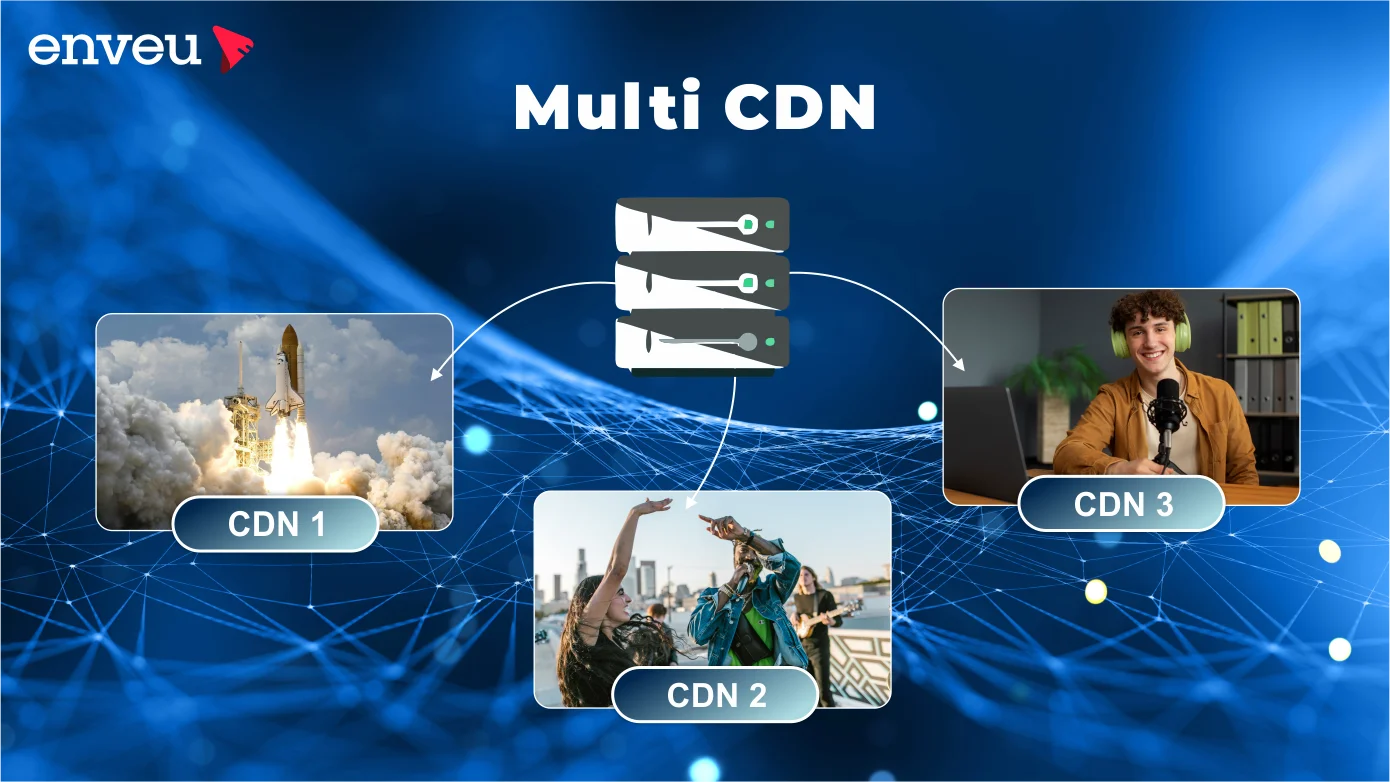Are you looking for a powerful live streaming strategy that can give high-quality video content to your audience? Well, nothing beats live streaming CDNs. It plays an important part in optimizing delivery to ensure the quality of video files as they are transported to viewers all over the world. It contributes to taking the advantages of CDNs to the next level. In this blog, we’ll discuss everything about multi CDNs for better live streaming performance.
Table of Contents
What is a Multi-CDN?
A Content Delivery Network (CDN) is a collection of servers that cache content near the end user. It makes it easier to transfer assets necessary for loading Internet content, such as HTML pages, JavaScript files, stylesheets, images, and videos.CDN services are becoming increasingly popular, and they now handle the majority of web traffic, including traffic from major websites like Facebook, Netflix, and Amazon.
How Is a Multi-CDN Different from a CDN?
Single CDN
A single CDN solution is appropriate for firms who are just targeting specific geographic areas and are currently in the process of extending their website content distribution globally.
If website content/applications are mostly static, a single CDN solution may enough for the majority of market needs; but, if traffic is above average, media streaming, social networking platforms, or web-based applications may struggle to provide material to consumers.
Multiple CDNs
While one CDN may be adequate in a given place, a site owner may decide to construct additional CDNs with data centers in geographical areas where the primary supply is underrepresented. Multi CDNs are preferred over single CDNs due to variations in performance across geographical locations.
- Certain CDN providers are not as reliable as others.
- Not all CDN providers offer the same features and techniques as others.
- You don’t need to switch CDN providers because the process is automated.
It’s the next big thing in e-commerce.
One reason organizations prefer Multi CDNs is to avoid putting all their eggs in one basket. While one CDN service may promise to give 100% uptime, in reality, even the top CDN provider.
How Does a Multi-CDN Work?
Multi-CDNs route traffic to several CDNs throughout the network. Various CDN implementations use different factors to select routing decisions. Some common multi-CDN strategies include:
Static DNS: In a multiple-CDN configuration, static IP addresses can be assigned to each of the content delivery networks. For example, high-speed video streaming traffic may be sent to StackPath’s CDN, whilst static downloads may be routed to another CDN.
Managed DNS services supplement traditional DNS solutions by delivering additional intelligence. Smart DNS decreases the amount of manual effort required to direct web traffic while boosting fault tolerance. Smart DNS, as opposed to static DNS, does not take into account cost or speed when selecting routes.
Round-Robin: A round-robin solution to multi-CDN routing entails spreading requests among various CDNs in a rotating manner. For example, in a two-CDN arrangement, the CDN with the best performance (highest score) handles the initial request, followed by the other CDN, and so on.
Top Benefits of a Multi-CDN Service Provider
Network Redundancy The advantage of a multi-CND strategy is redundancy. Its continuously improve its reliability. The primary and most important advantage of a Multi-CDN strategy is redundancy, and, consequently, improved reliability. Outages are common; a worldwide outage could bring down the entire network, while a local outage might force the CDN provider to serve traffic from a non-local PoP.
Users would thus experience a drop in performance, which often resulted in the application becoming unusable. Local outages happen every week or sometimes even every day, whereas these occurrences happen “only” a few times annually.
Enhanced Productivity
One of the main advantages of using several CDN providers is improved content delivery performance for end users. Different CDN providers cover different regions to different degrees. When using a single CDN, the company is dependent on the server infrastructure and geographic coverage of the CDN provider. This coverage may not always meet the needs of the organization.
You may always switch to the content delivery network (CDN) that gives your users the best coverage and latency by spreading your content across a few of them. The faster load times that follow will improve the user experience.
Cost Optimization
Content delivery costs can be minimized with the use of M-CDN settings. Use of many CDN types at various times is how this is accomplished. Despite providing many features, such edge computing and security services, high-end premium CDNs are pricey. Conversely, ordinary CDNs come at a lower cost but provide a somewhat smaller range of features. Organizations can reduce expenses by utilizing basic CDNs for simple or low-importance jobs, and by using premium CDNs for those exact same tasks.
Conclusion
A M-CDN can be very beneficial for your organization, ensuring your traffic is always optimized and all global users get first-class citizen treatment. When determining how to transition from a single CDN vendor to a M-CDN, the first and most critical step is to define your KPIs. This will help you ensure you are an route to the desired outcome.
When you begin the transition, make sure to take it slowly and implement the new setup gradually. It is also recommended to have experienced professionals accompany you throughout the process. They will help you avoid any mistakes and ensure you and your users can benefit from the reliability and improved performance a Multi-CDN can provide.
Many CDN providers also give reasonably priced packages and bundles. Picking the most cost-effective option for every region or kind of traffic will help businesses reduce their overall CDN expenses.
